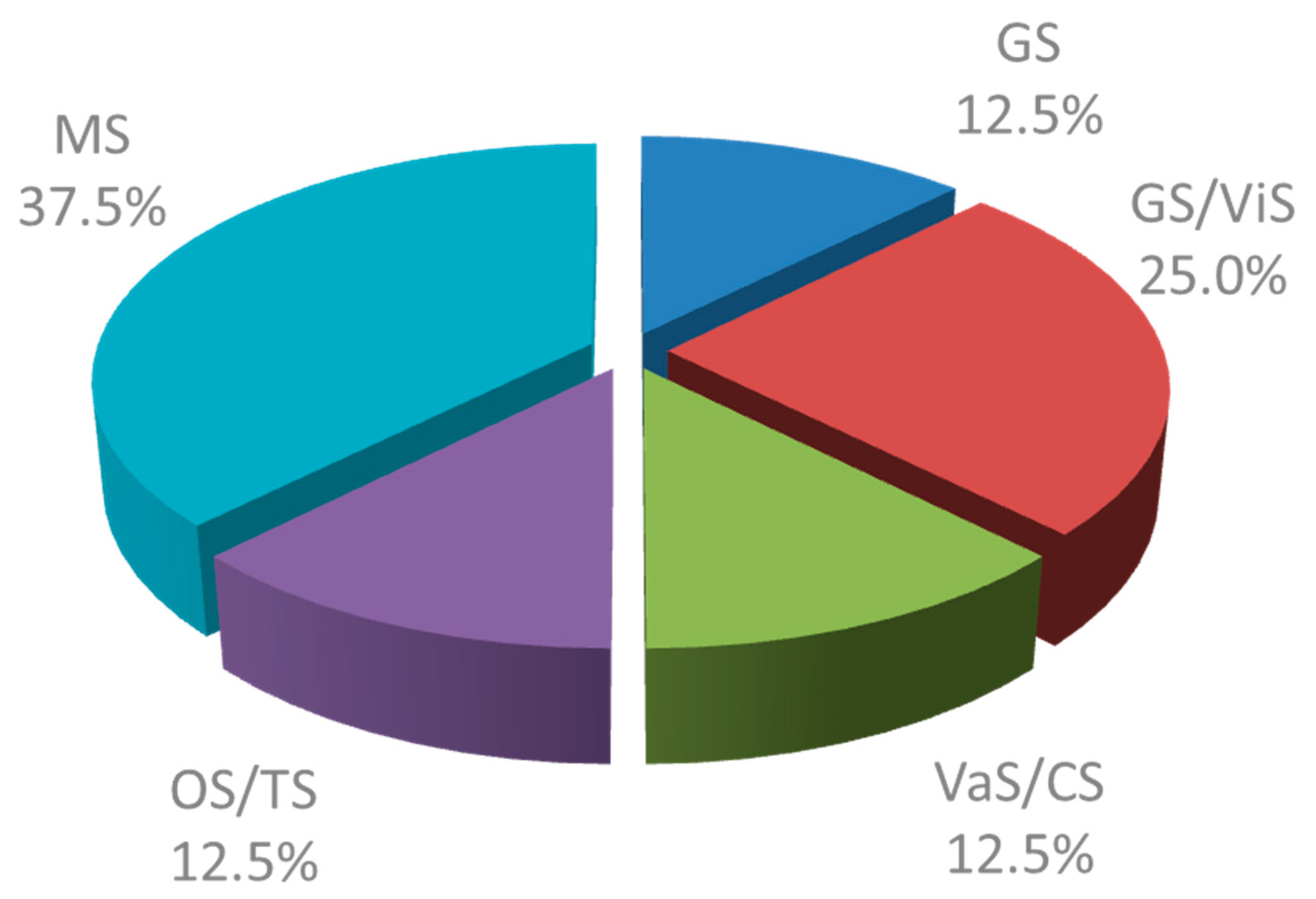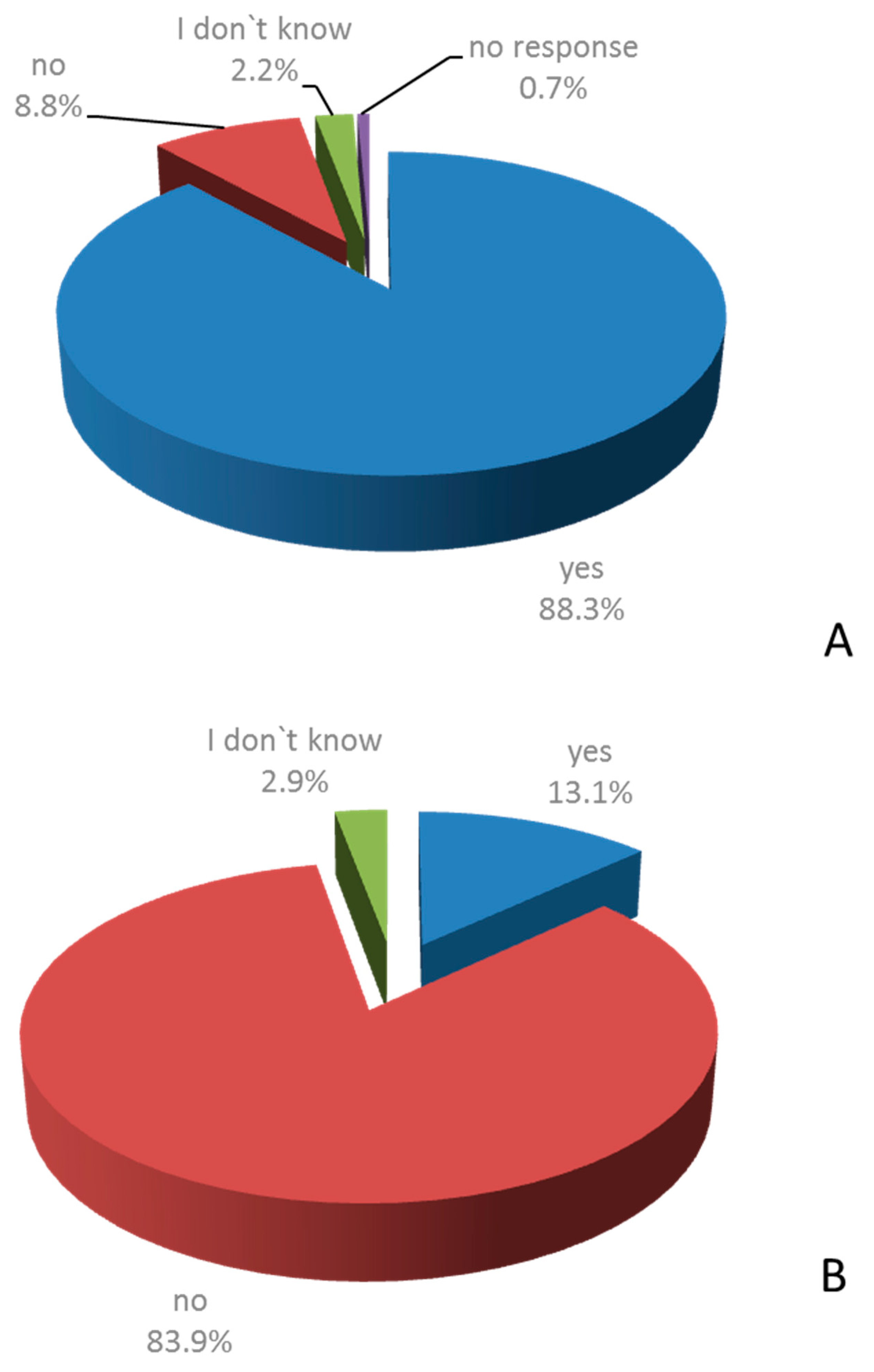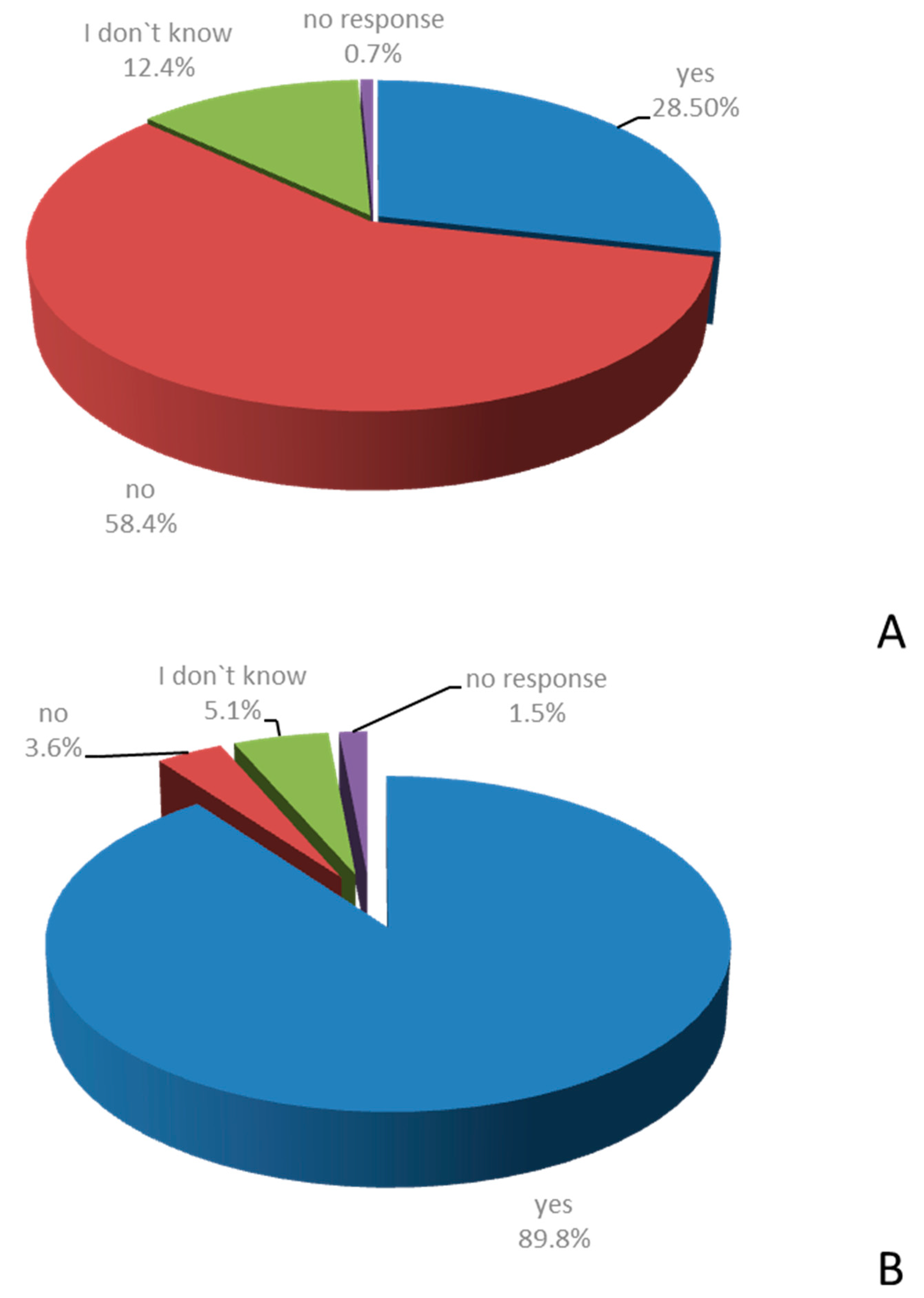Current Practice of Stress Ulcer Prophylaxis in Surgical Departments in Mecklenburg Western Pomerania, Germany
Abstract
:1. Introduction
2. Materials and Methods
3. Results
3.1. Characterization of Responding Heads of Department and Staff Members
3.2. Existence of Standard Operating Procedures Concerning SUP in Surgical Departments
3.3. Current Practice of SUP in Surgical Departments in Mecklenburg West Pomerania
3.4. Individual Knowledge in Stress Ulcer Disease and Prophylaxis
4. Discussion
5. Conclusions
Supplementary Materials
Author Contributions
Funding
Institutional Review Board Statement
Data Availability Statement
Conflicts of Interest
References
- Gullotta, R.; Ferraris, L.; Cortelezzi, C.; Minoli, G.; Prada, A.; Comin, U.; Rocca, F.; Ferrara, A.; Curzio, M. Impact of a pharmacist-driven protocol to decrease proton pump inhibitor use in non-intensive care hospitalized adults. Ital. J. Gastroenterol. Hepatol. 1997, 29, 325–329. [Google Scholar] [PubMed]
- Zink, D.A.; Pohlman, M.; Barnes, M.; Cannon, M.E. Long-term use of acid suppression started inappropriately during hospitalization. Aliment Pharm. 2005, 21, 1203–1209. [Google Scholar] [CrossRef] [PubMed]
- Nardino, R.J.; Vender, R.J.; Herbert, P.N. Overuse of acid-suppressive therapy in hospitalized patients. Am. J. Gastroenterol. 2000, 95, 3118–3122. [Google Scholar] [CrossRef] [PubMed]
- Pham, C.Q.; Regal, R.E.; Bostwick, T.R.; Knauf, K.S. Acid suppressive therapy use on an inpatient internal medicine service. Ann. Pharm. 2006, 40, 1261–1266. [Google Scholar] [CrossRef]
- Sheikh-Taha, M.; Alaeddine, S.; Nassif, J. Use of acid suppressive therapy in hospitalized non-critically ill patients. World 2012, 3, 93–96. [Google Scholar] [CrossRef]
- Hong, M.T.; Monye, L.C.; Seifert, C.F. Acid Suppressive Therapy for Stress Ulcer Prophylaxis in Noncritically Ill Patients. Ann Pharm. 2015, 49, 1004–1008. [Google Scholar] [CrossRef]
- Heidelbaugh, J.J.; Inadomi, J.M. Magnitude and economic impact of inappropriate use of stress ulcer prophylaxis in non-ICU hospitalized patients. Am. J. Gastroenterol. 2006, 101, 2200–2205. [Google Scholar] [CrossRef] [PubMed] [Green Version]
- Walker, N.M.; McDonald, J. An evaluation of the use of proton pump inhibitors. Pharm. World Sci. 2001, 23, 116–117. [Google Scholar] [CrossRef]
- Scagliarini, R.; Magnani, E.; Pratico, A.; Bocchini, R.; Sambo, P.; Pazzi, P. Inadequate use of acid-suppressive therapy in hospitalized patients and its implications for general practice. Dig. Dis. Sci. 2005, 50, 2307–2311. [Google Scholar] [CrossRef]
- Bez, C.; Perrottet, N.; Zingg, T.; Leung Ki, E.L.; Demartines, N.; Pannatier, A. Stress ulcer prophylaxis in non-critically ill patients: A prospective evaluation of current practice in a general surgery department. J. Eval. Clin. Pr. 2013, 19, 374–378. [Google Scholar] [CrossRef]
- Parente, F.; Cucino, C.; Gallus, S.; Bargiggia, S.; Greco, S.; Pastore, L.; Bianchi Porro, G. Hospital use of acid-suppressive medications and its fall-out on prescribing in general practice: A 1-month survey. Aliment. Pharm. 2003, 17, 1503–1506. [Google Scholar] [CrossRef]
- Czaja, A.J.; McAlhany, J.C.; Pruitt, B.A., Jr. Acute gastroduodenal disease after thermal injury. An endoscopic evaluation of incidence and natural history. N. Engl. J. Med. 1974, 291, 925–929. [Google Scholar] [CrossRef] [PubMed]
- Fogelman, M.J.; Garvey, J.M. Acute gastroduodenal ulceration incident to surgery and disease. Analysis and review of eighty-eight cases. Am. J. Surg. 1966, 112, 651–656. [Google Scholar] [CrossRef]
- Krag, M.; Perner, A.; Wetterslev, J.; Wise, M.P.; Borthwick, M.; Bendel, S.; McArthur, C.; Cook, D.; Nielsen, N.; Pelosi, P.; et al. Stress ulcer prophylaxis in the intensive care unit: An international survey of 97 units in 11 countries. Acta Anaesthesiol. Scand. 2015, 59, 576–585. [Google Scholar] [CrossRef] [PubMed]
- Erstad, B.L.; Barletta, J.F.; Jacobi, J.; Killian, A.D.; Kramer, K.M.; Martin, S.J. Survey of stress ulcer prophylaxis. Crit. Care. 1999, 3, 145–149. [Google Scholar] [CrossRef] [Green Version]
- Madsen, K.R.; Lorentzen, K.; Clausen, N.; Oberg, E.; Kirkegaard, P.R.; Maymann-Holler, N.; Moller, M.H. Guideline for stress ulcer prophylaxis in the intensive care unit. Dan 2014, 61, C4811. [Google Scholar]
- ASHP. ASHP Therapeutic Guidelines on Stress Ulcer Prophylaxis. ASHP Commission on Therapeutics and approved by the ASHP Board of Directors on November 14, 1998. Am. J. Health Syst. Pharm. 1999, 56, 347–379. [Google Scholar]
- Rhodes, A.; Evans, L.E.; Alhazzani, W.; Levy, M.M.; Antonelli, M.; Ferrer, R.; Kumar, A.; Sevransky, J.E.; Sprung, C.L.; Nunnally, M.E.; et al. Surviving Sepsis Campaign: International Guidelines for Management of Sepsis and Septic Shock: 2016. Intensive Care Med. 2017, 43, 304–377. [Google Scholar] [CrossRef]
- Ajumobi, A.B.; Vuong, R.; Ahaneku, H. Analysis of nonformulary use of PPIs and excess drug cost in a Veterans Affairs population. J. Manag. Care Pharm. 2012, 18, 63–67. [Google Scholar] [CrossRef] [PubMed] [Green Version]
- Wei, L.; Ratnayake, L.; Phillips, G.; McGuigan, C.C.; Morant, S.V.; Flynn, R.W.; Mackenzie, I.S.; MacDonald, T.M. Acid-suppression medications and bacterial gastroenteritis: A population-based cohort study. Br. J. Clin. Pharm. 2017, 83, 1298–1308. [Google Scholar] [CrossRef] [PubMed] [Green Version]
- Arora, P.; Gupta, A.; Golzy, M.; Patel, N.; Carter, R.L.; Jalal, K.; Lohr, J.W. Proton pump inhibitors are associated with increased risk of development of chronic kidney disease. BMC Nephrol. 2016, 17, 016–0325. [Google Scholar] [CrossRef] [PubMed] [Green Version]
- Lam, J.R.; Schneider, J.L.; Zhao, W.; Corley, D.A. Proton pump inhibitor and histamine 2 receptor antagonist use and vitamin B12 deficiency. JAMA 2013, 310, 2435–2442. [Google Scholar] [CrossRef] [PubMed] [Green Version]
- Almario, C.V.; Chey, W.D.; Spiegel, B.M.R. Increased Risk of COVID-19 Among Users of Proton Pump Inhibitors. Am. J. Gastroenterol. 2020, 115, 1707–1715. [Google Scholar] [CrossRef]
- Malfertheiner, P.; Kandulski, A.; Venerito, M. Proton-pump inhibitors: Understanding the complications and risks. Nat. Rev. Gastroenterol. Hepatol. 2017, 14, 697–710. [Google Scholar] [CrossRef]
- Rauch, J.; Patrzyk, M.; Heidecke, C.D.; Schulze, T. Current practice of stress ulcer prophylaxis in a surgical patient cohort in a German university hospital. Langenbecks Arch. Surg. 2021. Online ahead of print. [Google Scholar] [CrossRef]
- Krag, M.; Perner, A.; Wetterslev, J.; Wise, M.P.; Borthwick, M.; Bendel, S.; McArthur, C.; Cook, D.; Nielsen, N.; Pelosi, P.; et al. Prevalence and outcome of gastrointestinal bleeding and use of acid suppressants in acutely ill adult intensive care patients. Intensive Care Med. 2015, 41, 833–845. [Google Scholar] [CrossRef]
- Wohlt, P.D.; Hansen, L.A.; Fish, J.T. Inappropriate continuation of stress ulcer prophylactic therapy after discharge. Ann. Pharm. 2007, 41, 1611–1616. [Google Scholar] [CrossRef]
- Murphy, C.E.; Stevens, A.M.; Ferrentino, N.; Crookes, B.A.; Hebert, J.C.; Freiburg, C.B.; A Rebuck, J. Frequency of inappropriate continuation of acid suppressive therapy after discharge in patients who began therapy in the surgical intensive care unit. Pharmacotherapy 2008, 28, 968–976. [Google Scholar] [CrossRef] [PubMed]
- Brusselaers, N.; Wahlin, K.; Engstrand, L.; Lagergren, J. Maintenance therapy with proton pump inhibitors and risk of gastric cancer: A nationwide population-based cohort study in Sweden. BMJ Open 2017, 7, 2017–017739. [Google Scholar] [CrossRef] [Green Version]
- Brusselaers, N.; Sadr-Azodi, O.; Engstrand, L. Long-term proton pump inhibitor usage and the association with pancreatic cancer in Sweden. J. Gastroenterol. 2020, 55, 453–461. [Google Scholar] [CrossRef] [Green Version]
- Xie, Y.; Bowe, B.; Yan, Y.; Xian, H.; Li, T.; Al-Aly, Z. Estimates of all cause mortality and cause specific mortality associated with proton pump inhibitors among US veterans: Cohort study. BMJ 2019, 365, 11580. [Google Scholar] [CrossRef] [PubMed] [Green Version]
- Regal, R.E.; Osta, A.D.; Parekh, V.I. Interventions to curb the overuse of Acid-suppressive medications on an inpatient general medicine service. Pharm. Ther. 2010, 35, 86–90. [Google Scholar] [PubMed]
- Fischbach, W.; Darius, H.; Gross, M.; Koop, H.; Kruck, I.; Petersen, K.U. Concomitant use of platelet aggregation inhibitors and proton pump inhibitors (PPIs): Position paper of the German Society for Digestive and Metabolic Diseases (DGVS) and the German Society of Cardiology (DGK). Z. Gastroenterol. 2010, 48, 1156–1163. [Google Scholar] [CrossRef] [PubMed]
- Fischbach, W.; Malfertheiner, P.; Lynen Jansen, P.; Bolten, W.; Bornschein, J.; Buderus, S.; Glocker, E.; Hoffmann, C.J.; Koletzko, S.; Labenz, J.; et al. S2k-guideline Helicobacter pylori and gastroduodenal ulcer disease. Z. Gastroenterol. 2016, 54, 327–363. [Google Scholar] [PubMed] [Green Version]
- Herzig, S.J.; Rothberg, M.B.; Feinbloom, D.B.; Howell, M.D.; Ho, K.K.; Ngo, L.H.; Marcantonio, E.R. Risk factors for nosocomial gastrointestinal bleeding and use of acid-suppressive medication in non-critically ill patients. J. Gen. Intern. Med. 2013, 28, 683–690. [Google Scholar] [CrossRef] [Green Version]
- Khalili, H.; Dashti-Khavidaki, S.; Hossein Talasaz, A.H.; Tabeefar, H.; Hendoiee, N. Descriptive analysis of a clinical pharmacy intervention to improve the appropriate use of stress ulcer prophylaxis in a hospital infectious disease ward. J. Manag. Care Pharm. 2010, 16, 114–121. [Google Scholar] [CrossRef] [PubMed] [Green Version]
- Coursol, C.J.; Sanzari, S.E. Impact of stress ulcer prophylaxis algorithm study. Ann. Pharm. 2005, 39, 810–816. [Google Scholar] [CrossRef]
- Mostafa, G.; Sing, R.F.; Matthews, B.D.; Pratt, B.L.; Norton, H.J.; Heniford, B.T. The economic benefit of practice guidelines for stress ulcer prophylaxis. Am. Surg. 2002, 68, 146–150. [Google Scholar]
- Buckley, M.S.; Park, A.S.; Anderson, C.S.; Barletta, J.F.; Bikin, D.S.; Gerkin, R.D.; O’Malley, C.W.; Wicks, L.M.; Garcia-Orr, R.; Kane-Gill, S.L. Impact of a clinical pharmacist stress ulcer prophylaxis management program on inappropriate use in hospitalized patients. Am. J. Med. 2015, 128, 905–913. [Google Scholar] [CrossRef]
- Michal, J.; Henry, T.; Street, C. Impact of a pharmacist-driven protocol to decrease proton pump inhibitor use in non-intensive care hospitalized adults. Am. J. Health Syst. Pharm. 2016, 73 (17-Suppl. 4), S126–S132. [Google Scholar] [CrossRef]
- Hatch, J.B.; Schulz, L.; Fish, J.T. Stress ulcer prophylaxis: Reducing non-indicated prescribing after hospital discharge. Ann. Pharm. 2010, 44, 1565–1571. [Google Scholar] [CrossRef] [PubMed]
- Hughes, G.J.; Belgeri, M.T.; Perry, H.M. The impact of pharmacist interventions on the inappropriate use of acid-suppression therapy. Consult. Pharm. 2011, 26, 485–490. [Google Scholar] [CrossRef] [PubMed]




| Type of Department | Number (%) |
|---|---|
| General Surgery | 1 (4) |
| General and Visceral Surgery | 5 (20) |
| Vascular and Cardiac Surgery | 1 (4) |
| Orthopaedic and Trauma Surgery | 8 (32) |
| Mixed Surgical Departments | 10 (40) |
| Size of Hospital (beds) | Number (%) |
| <100 | 3 (12) |
| 100–500 | 16 (64) |
| >500 | 6 (24) |
| HoD Responding n = 120 (%) | HoD Not Responding n = 17 (%) | ||
|---|---|---|---|
| Principal professional activity | |||
| General Surgery | 42 (35) | 13 (76.5) | p = 0.05 |
| Visceral Surgery | 16 (13.3) | 1 (5.9) | |
| Vascular and Cardiac Surgery | 12 (10) | 1 (5.9) | |
| Orthopaedics and Trauma | 41 (34.2) | 2 (11.7) | |
| Intermediate Care/Intensive Care | 5 (4.2) | 0 (0) | |
| Others | 4 (3.3) | 0 (0) | |
| No answers | 0 (0) | 0 (0) | |
| Size of Hospital (beds) | |||
| <100 | 9 (7.5) | 7 (41.2) | p = 0.00 |
| 100–500 | 64 (53.3) | 2 (11.7) | |
| >500 | 47 (39.2) | 8 (47.1) | |
| Professional experience | |||
| Resident < 2 years (Assistenzarzt) | 15 (12.5) | 3 (17.6) | p = 0.55 |
| Resident > 2 years (Assistenzarzt) | 37 (30.8) | 4 (23.5) | |
| Specialist | 29 (24.2) | 2 (11.8) | |
| Consultant | 39 (32.5) | 8 (47.1) | |
| Departments with SOP for SUP (n = 8) | Departments without SOP for SUP (n = 17) | ||
|---|---|---|---|
| Intensive care unit | |||
| no answer | 0 | 1 (5.9) | p = 0.49 |
| yes | 7 (87.5) | 10 (58.8) | |
| no | 0 | 2 (11.8) | |
| risk adapted | 1 (12.5) | 4 (23.5) | |
| General hospital ward | |||
| no answer | 0 | 1 (5.9) | p = 0.46 |
| yes | 2 (25) | 1 (5.9) | |
| no | 2 (25) | 7 (41.2) | |
| risk adapted | 4 (50) | 8 (47.1) | |
| Reassessment of Indications for SUP upon Transfer from the ICU to the GHW According to SOP n = 42 | Discontinuation of SUP after Hospital Discharge According to SOP n = 42 | |
|---|---|---|
| yes | 12 (28.6) | 8 (19.1) |
| no | 7 (16.7) | 5 (11.9) |
| no answer | 20 (47.6) | 20 (47.6) |
| other | 3 (7.1) | 9 (21.4) |
| General Surgery n = 55 | Visceral Surgery n = 17 | Vascular Surgery n = 13 | ICU/IMC n = 5 | Trauma/ Orthopaedics n = 43 | Others n = 4 | ||
|---|---|---|---|---|---|---|---|
| Reassessment of SUP indications upon transfer from ICU to normal ward | |||||||
| systematically | 8 (14.5) | 6 (35.3) | 1 (7.7) | 1 (20) | 13 (30.2) | 0 | |
| frequently | 17 (30.9) | 5 (29.4) | 4 (30.8) | 3 (60) | 3 (7.0) | 0 | |
| occasionally | 15 (27.3) | 4 (23.5) | 4 (30.8) | 0 | 8 (18.6) | 0 | p = 0.00 |
| rarely | 12 (21.8) | 1 (5.9) | 3 (23.1) | 0 | 13 (30.2) | 1 (25.0) | |
| never | 2 (3.6) | 0 | 0 | 0 | 5 (11.6) | 3 (75.0) | |
| no response | 1 (1.8) | 1 (5.9) | 1 (7.7) | 1 (20) | 1 (2.3) | 0 | |
| Reassessment of SUP indications before hospital discharge | |||||||
| systematically | 11 (20.0) | 8 (47.1) | 2 (15.4) | 3 (60.0) | 9 (20.9) | 0 | |
| frequently | 22 (40.0) | 5 (29.4) | 2 (15.4) | 2 (40.0) | 12 (27.9) | 0 | |
| occasionally | 13 (23.6) | 4 (23.5) | 5 (38.5) | 0 | 5 (11.6) | 0 | p = 0.01 |
| rarely | 7 (12.7) | 0 | 4 (30.8) | 0 | 10 (23.3) | 3 (75.0) | |
| never | 1 (1.8) | 0 | 0 | 0 | 5 (11.6) | 1 (25.0) | |
| no response | 1 (1.8) | 0 | 0 | 0 | 2 (4.7) | 0 | |
| % of Participating MSMs (n = 137) | |
|---|---|
| Underestimation of more than 50% | 16 (11.7) |
| Correct estimation | 28 (20.4) |
| Overestimation of more than 50% | 32 (23.4) |
| Overestimation of more than 100% | 3 (2.1) |
| Overestimation of more than 200% | 54 (39.4) |
| No answer | 4 (2.9) |
Publisher’s Note: MDPI stays neutral with regard to jurisdictional claims in published maps and institutional affiliations. |
© 2021 by the authors. Licensee MDPI, Basel, Switzerland. This article is an open access article distributed under the terms and conditions of the Creative Commons Attribution (CC BY) license (https://creativecommons.org/licenses/by/4.0/).
Share and Cite
Rauch, J.; Franze, M.; Patrzyk, M.; Heidecke, C.-D.; Schulze, T. Current Practice of Stress Ulcer Prophylaxis in Surgical Departments in Mecklenburg Western Pomerania, Germany. Healthcare 2021, 9, 1490. https://doi.org/10.3390/healthcare9111490
Rauch J, Franze M, Patrzyk M, Heidecke C-D, Schulze T. Current Practice of Stress Ulcer Prophylaxis in Surgical Departments in Mecklenburg Western Pomerania, Germany. Healthcare. 2021; 9(11):1490. https://doi.org/10.3390/healthcare9111490
Chicago/Turabian StyleRauch, Julia, Marco Franze, Maciej Patrzyk, Claus-Dieter Heidecke, and Tobias Schulze. 2021. "Current Practice of Stress Ulcer Prophylaxis in Surgical Departments in Mecklenburg Western Pomerania, Germany" Healthcare 9, no. 11: 1490. https://doi.org/10.3390/healthcare9111490
APA StyleRauch, J., Franze, M., Patrzyk, M., Heidecke, C.-D., & Schulze, T. (2021). Current Practice of Stress Ulcer Prophylaxis in Surgical Departments in Mecklenburg Western Pomerania, Germany. Healthcare, 9(11), 1490. https://doi.org/10.3390/healthcare9111490






